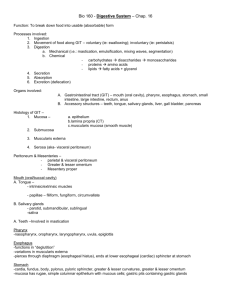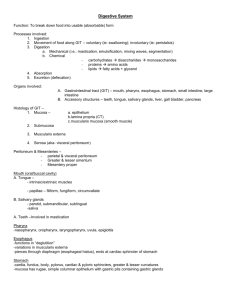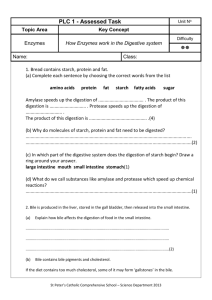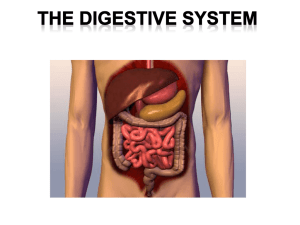Chapter 23
advertisement
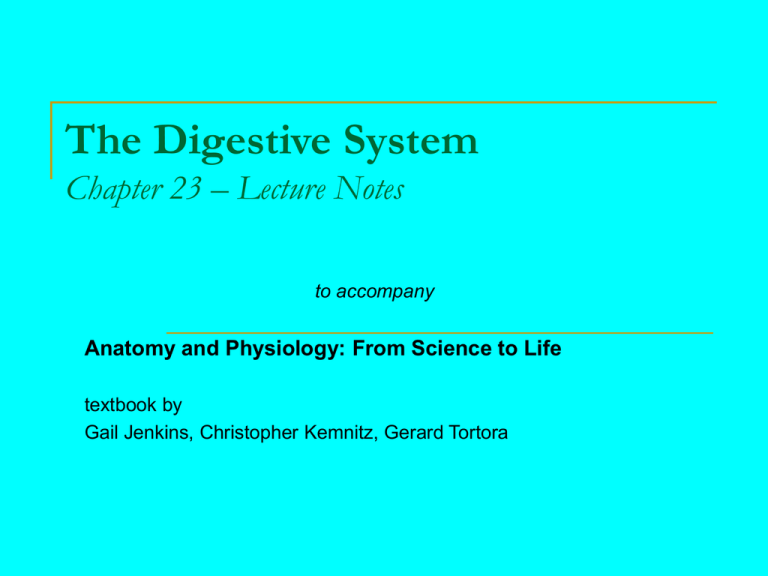
The Digestive System Chapter 23 – Lecture Notes to accompany Anatomy and Physiology: From Science to Life textbook by Gail Jenkins, Christopher Kemnitz, Gerard Tortora Chapter Overview 23.1 Gastrointestinal (GI) Tract 23.2 Accessory Organs of the Head 23.3 Swallowing 23.4 Stomach 23.5 Accessory Organs of the Abdomen 23.6 Small Intestine 23.7 Large Intestine 23.8 Phases of Digestion 23.9 Food Molecules 23.10 Metabolism Essential Terms digestion process of mechanically or chemically breaking down food absorption passage of small molecules into blood and lymph digestive system organs which carry out process of digestion and absorption metabolism all the chemical reactions of the body Introduction Digestive System 1. 2. 3. 4. Composed of GI tract and accessory organs Breaks down ingested food for use by the body Digestion occurs by mechanical and chemical mechanisms Excretes waste products or feces through process of defecation Concept 23.1 Gastrointestinal (GI) Tract GI Tract / Alimentary Canal Continuous tube from mouth to anus Mouth Pharynx Esophagus Stomach Small intestine Large intestine Accessory Digestive Organs Provide mechanical and chemical mechanisms to aid digestion Teeth Tongue Salivary glands Liver Gallbladder Pancreas Figure 23.1 Functions of Digestive System Ingestion Secretion Mixing and propulsion 1. 2. 3. • Digestion 4. • 5. 6. Motility Mechanical and chemical Absorption Defecation Layers of GI Tract Same in all areas of GI tract From deep to superficial: Mucosa Submucosa Muscularis Serosa Figure 23.2 Layers of GI Tract Mucosa Epithelium Lamina propria – areolar connective tissue Type varies MALT – mucus-associated lymphatic tissue Muscularis mucosae – smooth muscle Submucosa Areolar connective tissue Blood and lymphatic vessels Neurons – submucosal plexus Layers of GI Tract Muscularis Skeletal and smooth muscle Neurons – myenteric plexus Serosa Areolar and simple squamous epithelium Visceral peritoneum Peritoneum Mesothelium Parietal peritoneum Visceral peritoneum Peritoneal cavity Retroperitoneal Figure 23.3a Figure 23.3b Figure 23.3c Figure 23.3d Folds of Peritoneum Greater omentum Falciform ligament Liver to anterior abdominal wall Lesser omentum Mesentery Adipose tissue Small intestine to posterior abdominal wall Mesocolon Neural Innervation of GI Tract Regulated by autonomic nervous system Enteric division Myenteric plexus / plexus of Auerbach Submucosal plexus / plexus of Meissner Able to function independently from rest of nervous system Linked to CNS by extrinsic sympathetic and parasympathetic nerves Sympathetic nerves decrease GI secretions & motility Parasympathetic nerves increase GI secretion and motility Concept 23.2 Accessory Organs of the Head Mouth Parts of Digestive System Mouth formed by several parts: Cheeks Lips / labia Labial frenulum Orbicularis Vestibule Oral cavity proper Fauces Hard and soft palate Uvula Palatoglossal and palatopharyngeal arch Figure 23.4 Tongue Skeletal muscle and mucous membrane Helps form floor of oral cavity Extrinsic muscles Intrinsic muscles Lingual frenulum Papillae Fungiform Filiform Circumvallate Foliate Lingual glands Lingual lipase Salivary Glands Release saliva to oral cavity 3 pairs of salivary glands Parotid Submandibular Sublingual Composition of Saliva 99.5 % water 0.5% other solutes Ions Mucus Immunoglobulin A Enzymes Salivation controlled by autonomic nervous system Stimulated by various mechanisms Figure 23.5 Teeth External regions Crown Root Neck 1. 2. 3. Internal components Enamel Dentin 1. 2. Cementum Pulp cavity 3. PulpRoot canals Apical foramen Figure 23.6 Teeth Dentitions Deciduous teeth – first set Permanent teeth – secondary Carry out mechanical digestion by mastication Creates bolus Salivary amylase Breakdown starch Lingual lipase Breakdown triglycerides Figure 23.7 Table 23.1 Concept 23.3 Swallowing Pharynx Composed of skeletal muscle Lined by mucous membrane Nasopharynx Oropharynx Laryngopharynx Esophagus Collapsible muscular tube through esophageal hiatus of diaphragm Mucosa Muscularis Skeletal muscle Upper and lower esophageal sphincter Adventitia Submucosa contains areolar connective tissue Attaches esophagus to nearby structures Secrets mucus and transports food Figure 23.8 Deglutition Stages of swallowing Voluntary Pharyngeal Mouth to oropharynx Deglutition center in medulla oblongata and pons Closing of epiglottis Involuntary Esophageal Involuntary Peristaltic contractions Figure 23.9a,b Figure 23.9c Table 23.2 Concept 23.4 Stomach Stomach Serves as mixing chamber and storage area for ingested food Rugae allow for increased volume 4 main regions Cardia Fundus Body Pylorus 1. 2. 3. 4. Pyloric antrum and canal Pyloric sphincter Lesser and greater curvatures Figure 23.10a Stomach Histology Mucosa 1. Submucosa – areolar connective tissue Muscularis 2. 3. 4. Surface mucous cells Lamina propria Muscularis mucosae Gastric glands and pits Parietal cells Chief cells G cells 3 layers of smooth muscle Serosa Figure 23.11a Figure 23.11b Figure 23.11c Mechanical and Chemical Digestion Mixing waves caused by peristaltic movement Chyme released in process of gastric emptying Proton pumps bring H+ into the lumen Carbonic anhydrase forms carbonic acid to provide H+ and bicarbonate ions (HCO3-) Figure 23.12 Mechanical and Chemical Digestion Chemical digestion stimulated by nervous system Parasympathetic neurons release acetylcholine Pepsin begins digestion of proteins Works with gastrin HCl released in presence of histamine Stomach protected by alkaline mucus secretion Gastric lipase digests triglycerides Few molecules absorbed by stomach Water, ions, short-chain fatty acids, alcohol Table 23.3 pt 1 Table 23.3 pt 2 Concept 23.5 Accessory Organs of the Abdomen Pancreas Produces secretions to aid digestion Head Body Tail Pancreatic duct /duct of Wirsung Hepatopancreatic ampulla Sphincter of the heatopancreatic ampulla (sphincter of (Oddi) Regulates passage of pancreatic juice and bile Accessory duct (duct of Santorini) Figure 23.13a Figure 23.13b Figure 23.13c Histology of Pancreas Glandular epithelial cells 99% exocrine clusters Secrete pancreatic juice Fluid and enzymes Pancreatic islets (islets of Langerhans) 1% endocrine cells Hormones Glucagon Insulin Somatostatin Pancreatic polypeptide Pancreatic Juice 1200-1500 mL/day pH 7.1-8.2 Water Salts Sodium bicarbonate Enzymes Pancreatic amylase Trypsin Entereokinase Chymotrypsin Carboxypeptidase Elastase Pancreatic lipase Ribonuclease and deoxyribonuclease Liver and Gallbladder Liver Largest gland at 1.4 kg (~3 lb) Gallbladder Closely associated with liver Anatomy of Liver Right and left lobe separated by falciform ligament Quadrate lobe Caudate lobe Round ligament (ligamentum teres) Remnant of umbilical vein coronary ligaments Histology of Liver Lobule Hepatocytes radiating from central vein Sinusoids Reticuloendothelial (Kupffer) cells Stationary phagocytes Figure 23.14a Figure 23.14b Figure 23.14c Figure 23.14d Bile Duct System Bile secreted by hepatocytes Bile canaliculi Bile ducts Right and left hepatic ducts Common hepatic duct Common bile duct Gallbladder for temporary storage of bile Cystic duct Blood Supply of Liver Hepatic artery provides oxygenated blood Hepatic portal vein provides deoxygenated blood Hepatic artery and vein carry blood to sinusoids Nutrients, drugs, toxins, microbes Substances exchanged by hepatocytes Blood drains to central vein and eventually hepatic vein Portal triad Hepatic portal vein Hepatic artery Bile duct Figure 23.15 Bile 800-1000 mL/day pH 7.6 – 8.6 Water Bile acids Bile salts Emulsification Cholesterol Lecithin Bile pigments Bilirubin Stercobilin Liver Functions Metabolism of: Carbohydrates Lipids Proteins Process drugs and hormones Excrete bilirubin Synthesize bile salts Storage Glycogen Vtamins Minerals Phagocytosis Activate Vitamin D Concept 23.6 Small Intestine Small Intestine Adapted for digestion and absorption 3 m (10 ft) living 6.5 m (21 ft) without muscle tone Duodenum Jejunum Ileum Ileocecal sphincter Connection to large intestine Figure 23.16a Figure 23.16b Histology of Small Intestine Mucosa Cell types Absorptive Goblet Endocrine Paneth Lysozyme Intestinal glands (crypts of Lieberkühn) S cells Hormone secretin CCK cells Hormone – cholecystokinin (CCK) Figure 23.17a



